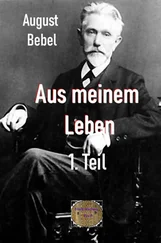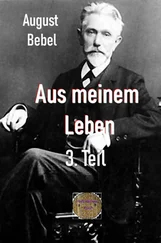August Bebel - Woman under socialism
Здесь есть возможность читать онлайн «August Bebel - Woman under socialism» — ознакомительный отрывок электронной книги совершенно бесплатно, а после прочтения отрывка купить полную версию. В некоторых случаях можно слушать аудио, скачать через торрент в формате fb2 и присутствует краткое содержание. ISBN: , Жанр: foreign_antique, foreign_prose, на английском языке. Описание произведения, (предисловие) а так же отзывы посетителей доступны на портале библиотеки ЛибКат.
- Название:Woman under socialism
- Автор:
- Жанр:
- Год:неизвестен
- ISBN:http://www.gutenberg.org/ebooks/30646
- Рейтинг книги:5 / 5. Голосов: 1
-
Избранное:Добавить в избранное
- Отзывы:
-
Ваша оценка:
- 100
- 1
- 2
- 3
- 4
- 5
Woman under socialism: краткое содержание, описание и аннотация
Предлагаем к чтению аннотацию, описание, краткое содержание или предисловие (зависит от того, что написал сам автор книги «Woman under socialism»). Если вы не нашли необходимую информацию о книге — напишите в комментариях, мы постараемся отыскать её.
Woman under socialism — читать онлайн ознакомительный отрывок
Ниже представлен текст книги, разбитый по страницам. Система сохранения места последней прочитанной страницы, позволяет с удобством читать онлайн бесплатно книгу «Woman under socialism», без необходимости каждый раз заново искать на чём Вы остановились. Поставьте закладку, и сможете в любой момент перейти на страницу, на которой закончили чтение.
Интервал:
Закладка:
Cunow furnishes the proofs for the correctness of the views in which he differs from Morgan on some points. But, however he may differ from Morgan in single instances, he emphatically defends him against the attacks of Westermann and others. He says:
"Although here and there a hypothesis of Morgan may have proved itself false, and some others may be allowed only a qualified approval, that merit none can gainsay him that he has been the first to establish the identity of the North American totem-group with the gentile organization of the Romans; and, secondly, to demonstrate that our modern systems of consanguinity and family-forms are the result of a long process of development. In a measure he has thereby first made recent investigations possible; he has first built the foundation on which we may build further." In the introduction also to his book he says expressly that his own work is partly a supplement to Morgan's book on primitive man.
The Westermanns, the Starckes, the Zieglers – the latter of whom, in his book, criticized in the introduction to the twenty-fifth edition of this work, refers mainly to the first named, in order to attack our statements with theirs – will have to submit, with good grace or bad, to the fact that the rise and development of the family has not taken the course that fits in with their bourgeois prejudices. The refutation that, in the last part of his work, Cunow bestows upon Westermann and Starcke, Ziegler's authorities, are calculated to enlighten their most fanatic followers upon the value of their caviling criticisms of, and arguments against, Morgan.
According to Morgan, the punaluan family has its start with the exclusion of consanguineous brothers and sisters, on the mother's side. Where a woman has several husbands, the evidence of paternity is impossible. Paternity becomes a fiction. Even to-day, under the rule of strict monogamous marriage, paternity, as Goethe, in his "Apprenticeship," lets Frederick say, "rests only upon faith." If with monogamy, paternity is often doubtful, it is impossible of proof in polygamy: only descent from the mother is certain and unquestionable. Accordingly, descent from the mother afforded the only criterion. As all deep-reaching transformations in the social relations of primitive man are accomplished only slowly, the change of the so-called consanguine into the punaluan family must unquestionably have engaged vast periods of time, and been broken through by many relapses, still noticeable in much later days. The proximate external inducement for the development of the punaluan family was, possibly, the necessity of splitting up the strongly swollen membership of the family, to the end that new grounds could be occupied for cattle ranges and agriculture. Probably, also, with the reaching of a higher grade of civilization, a sense gradually asserted itself of the harmfulness and indecorousness of sexual intercourse between brothers and sisters, and close relatives. In favor of this theory stands a pretty tradition, that, as related by Cunow, Gaston found among the Dieyeries, one of the South Australian tribes, on the rise of the "Mordu" consanguine group. He says:
"After creation, fathers, mothers, sisters, brothers and other near relatives married promiscuously among one another, until the evil effects of such connections showed themselves clearly. A conference of leaders was held, and it was considered in what way this could be avoided. The outcome of the conference was a request to the Muramura (Great Spirit); and he ordered in his answer that the tribe be divided into several branches, and that, in order to distinguish them, they be called by different names, after animate or inanimate objects. For instance: after the dingo, the mouse, the emu, the rain, the iguana-lizard, etc. The members of one and the same group could not marry another. The son of a Dingo could not, for instance, marry the daughter of a Dingo; each of the two could, however, enter into connections with the Mouse, the Emu, the Rat, or any other family."
This tradition is more sensible and natural, by a good deal, than the Christian tradition, taught by the Bible. It shows plainly the rise of the consanguine groups. Moreover, Paul Lafargue, makes in the "Neue Zeit" the sagacious, and, we think, felicitous point, that names, such as Adam and Eve, are not names of individual persons, but the names of gentes, in which, at the time, the Jews were joined. Lafargue solves by his argument a series of otherwise obscure and contradictory passages in the first Book of Moses. Again, M. Beer calls attention, likewise in the "Neue Zeit," that, to this day, it is a conjugal custom among Jews that the bride and the bridegroom's mother may not carry the same name , otherwise – thus runs this belief – a misfortune will befall the family: sickness and death will pursue them. In our opinion, this is a further proof for the correctness of Lafargue's theory. The gentile organization forbids marriage between persons that descend from the same gens stock. Such a common descent must be considered to exist, according to gentile principles, between the bride, that carries the name of "Eve," and the bridegroom's mother of the same name. Modern Jews, of course, have no longer the remotest suspicion of the real connection between their prejudice and their old gentile constitution, which forbade such marriages of relatives. The old gentile order had for its object to avoid the degenerating consequences of in-breeding. Although this gentile constitution has for thousands of years been destroyed among the Jews, tradition, as we see, has continued to live in superstition.
Quite possible, the experience, made at an early day with the breeding of animals, revealed the harmfulness of in-breeding. How far this experience went transpires from the manner in which, according to the first Book of Moses, chap. 30, verse 32 and sequel, Jacob understood how to outwit his father-in-law Laban, by knowing how to encompass the birth of eanlings that were streaked and pied, and which, according to Laban's promises, were to be Jacob's. The old Israelites had, accordingly, long before Darwin, studied Darwinism.
Once upon the subject of the conditions existing among the old Jews, a few other facts are in order, clearly proving that, among them, descent in the female line was actually in force of old. True enough, on the subject of woman, I Moses, 3, 16, runs this wise: "And thy desire shall be to thy husband, and he shall rule over thee;" and the verse also undergoes the variation: "the woman shall leave father and mother, and cleave to her husband." In point of fact, however, I Moses, 2, 24, has it this way: " Therefore shall a man leave his father and mother and shall cleave unto his wife , and they shall be one flesh." The same language recurs in Matthew 19, 15; Mark 10, 7, and in the Epistle to the Ephesians 5, 31. The command sprang, accordingly, from the system of descent in the female line, and the exegetists, at a loss what to do with it, allowed it to appear in a light that is utterly false.
Descent in female line appears clearly also in IV Moses, 32, 41. It is there said that Jair had a father, who was of the tribe of Judah, but his mother was of the tribe of Manasseh, and Jair is expressly called the son of Manasseh, and he inherited in that tribe. Another instance of descent in the female line among the Jews is met in Nehemiah 7, 63. There the children of a priest, who took to wife one of the daughters of Barzillai – a Jewish clan – are called children of Barzillai; they are, accordingly, not called after the father, who, moreover, as a priest occupied a privileged position, but after the mother. For the rest, already in the days of the Old Testament, accordingly, in historic times, the father-right prevailed among the Jews, and the clan and tribe organization rested on descent in the male line. Accordingly, the daughters were shut off as heirs, as may be seen in I Moses 31, 14-15, where even Leah and Rachel, the daughters of Laban, complain: "Is there yet any portion or inheritance for us in our father's house? Are we not counted of him strangers? for he has sold us, and hath quite devoured also our money."
Читать дальшеИнтервал:
Закладка:
Похожие книги на «Woman under socialism»
Представляем Вашему вниманию похожие книги на «Woman under socialism» списком для выбора. Мы отобрали схожую по названию и смыслу литературу в надежде предоставить читателям больше вариантов отыскать новые, интересные, ещё непрочитанные произведения.
Обсуждение, отзывы о книге «Woman under socialism» и просто собственные мнения читателей. Оставьте ваши комментарии, напишите, что Вы думаете о произведении, его смысле или главных героях. Укажите что конкретно понравилось, а что нет, и почему Вы так считаете.












